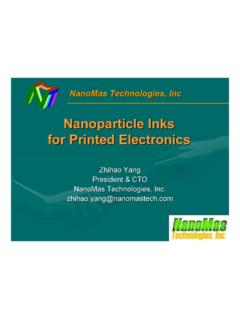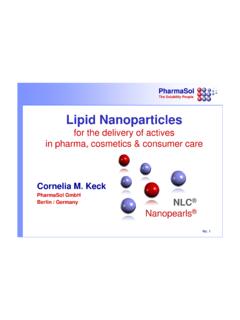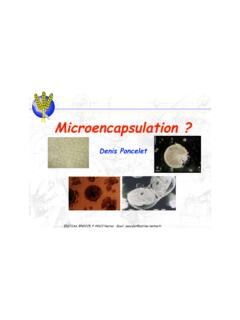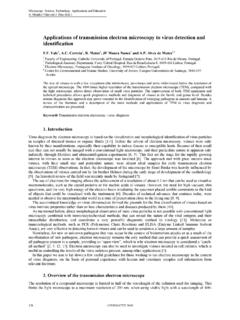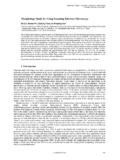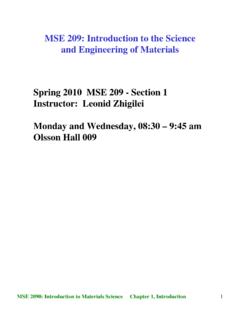Transcription of Part I: Introduction to Nanoparticle …
1 Part I: Introduction to Nanoparticle characterization with AFMJ ennifer Scalf, Paul WestPacific Nanotechnology, Scott Blvd., Suite 29 Santa Clara, CA I: Introduction to Nanoparticle characterization with for nanoparticles While nanoparticles are important in a diverse set of fields, they can generally be classified as one of two types: engineered or nonengineered. Engineered nanoparticles are intentionally designed and created with physical properties tailored to meet the needs of specific applications. They can be end products in and of themselves, as in the case of quantum dots or pharmaceutical drugs, or they can be components later incorporated into separate end products, such as carbon black in rubber products, shown in Figure 1.
2 Either way, the particle s physical properties are extremely important to their performance and the performance of any product into which they are ultimately incorporated. Nonengineered nanoparticles , on the other hand, are unintentionally generated or naturally produced, such as atmospheric nanoparticles created during combustion. with nonengineered nanoparticles , physical properties also play an important role as they determine whether or not ill effects will occur as a result of the presence of these particles. Depending on the application of interest, nanoparticles may be known by a number of alternative and trade-specific names, including particulate matter, aerosols, colloids, nanocomposites, nanopowders, and 1: Left: 15nm PMMA & LPPP polymer spheres in a crystallized emulsion of SDS.
3 (Data courtesy of University of Potsdam, Germany.) Right: Carbon black, commonly used to enhance the properties of manufactured rubber, is clearly visualized using the NANO-RP . Scan size is 2 m x 2 , a unique subset of the broad field of nanotechnology, include any type of particle with at least one dimension of less than 500 nanometers. nanoparticles play an important role in a wide variety of fields including advanced materials, pharmaceuticals, and environmental detection and monitoring. The atomic force microscope (AFM) is ideally suited for characterizing nanoparticles .
4 It offers the capability of 3D visualization and both qualitative and quantitative information on many physical properties including size, morphol-ogy, surface texture and roughness. Statistical information, including size, surface area, and volume distributions, can be determined as well. A wide range of particle sizes can be characterized in the same scan, from 1 nanometer to 8 micrometers. In addition, the AFM can characterize nanoparticles in multiple mediums including ambient air, controlled environments, and even liquid dispersions.
5 Jennifer Scalf, Paul WestPacific Nanotechnology3350 Scott Clara, CA 95054 Table 1: Examples of industries with engineered and non-engineered nanoparticles : Some industries with engineered nanoparticles : Some industries with nonengineered particles: Pharmaceuticals Performance Chemicals Environmental Detection Chemical Mechanical Polishing Quantum Dots Environmental Monitoring Biodetection and Labeling Ceramics Controlled Environments Food Products CosmeticsPart I: Introduction to Nanoparticle characterization with Capabilities in Nanoparticle characterization Qualitative Analysis Using the AFM, individual particles and groups of particles can be resolved.
6 Microscope images are essential in research and development projects and can be critical when troubleshooting quality control issues. The AFM offers visualization in three dimensions. Resolution in the vertical, or Z, axis is limited by the vibration environment of the instrument: whereas resolution in the horizontal, or X-Y, axis is limited by the diameter of tip utilized for scanning. Typically, AFM instruments have vertical resolutions of less than nm and X-Y resolutions of around 1 nm. In Figure 2, 73nm NIST traceable microspheres are shown in both perspective view and top view.
7 3D information is incorporated in both views. In the perspective view, the 3D nature of the image is obvious. In the top view, the intensity of the color reflects the height of the particle. In material sensing mode, the AFM can distinguish between different materials, providing spatial distribution information on composite materials with otherwise uninformative topographies. In Figure 3, material inhomogeneity can be seen on a topographically flat organic film. Similarly, nanocomposites can be analyzed for dispersion of particulate matter.
8 Quantitative Analysis Software-based image processing of AFM data can generate quantitative information from individual nanoparticles and between groups of nanoparticles . For individual particles, size information (length, width, and height) and other physical properties (such as morphology and surface texture) can be measured. In Figure 4, surface roughness data generated from a scan of a wood fiber is shown. Statistics on groups of particles can also be measured through image analysis and data processing. Commonly desired ensemble statistics include particle counts, particle size distribution, surface area distribution and volume distribution.
9 with knowledge of the material density, mass distribution can be easily calculated. Image processing of an AFM image is shown in Figure 5. Whenever data from single-particle techniques is processed to provide statistical information, the concern over statistical significance exists. It is easy to attain greater statistical significance in AFM by combining data from multiple scans to obtain information on the larger population. Figure 2: Left: NIST traceable polystyrene microspheres from Duke Scientific scanned with the NANO-RP . Mean of microspheres is 102nm.
10 Scan size is 1 m x 1 m. Right: 3D view of 1x1 m scan of calibrated 3: Left: Topography scan. Inhomogeneities in organic film on polymer substrate. Using material sensing mode on the NANO-RP allows observation of material inhomogeneities in nanocomposites with relatively flat topogra-phies. Right: Material Sensing mode scan. Both topography and phase images are obtained I: Introduction to Nanoparticle characterization with MediaAFM can be performed in liquid or gas mediums. This capability can be very advantageous for Nanoparticle characterization .
